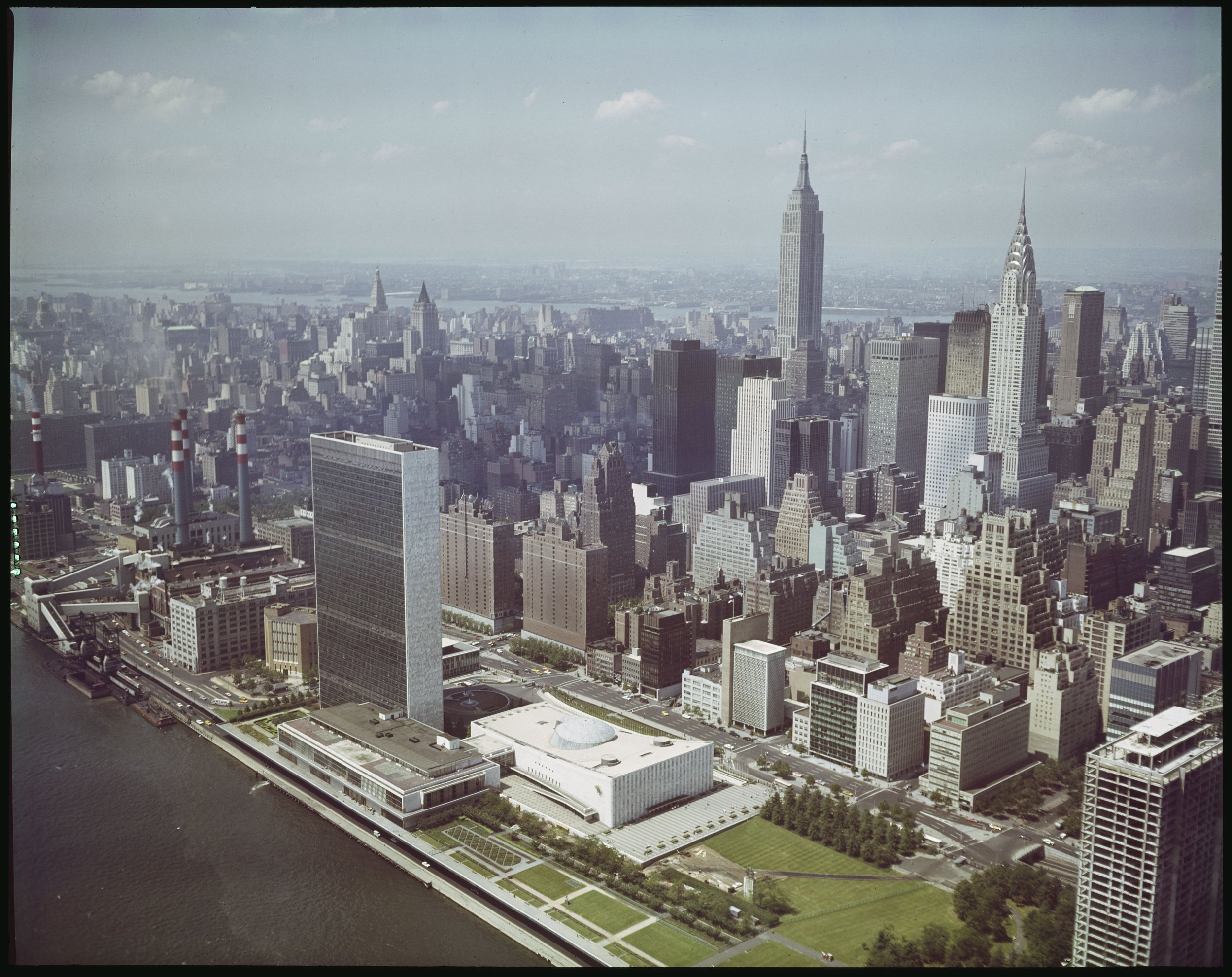This week, the 78th Session of the United Nations General Assembly convened at the United Nations Headquarters in New York City. According to the official United Nations website, “World leaders gather to engage in the annual high-level General Debate under the theme, ‘Rebuilding trust and reigniting global solidarity: Accelerating action on the 2030 Agenda and its Sustainable Development Goals towards peace, prosperity, progress and sustainability for all’.”
For the Record looks at the many resources in Municipal Archives and Library collections for researchers interested in documenting the history of the United Nations in New York City.
United Nations, aerial view, ca. 1962, transparency. Department of Ports and Trade photograph collection. NYC Municipal Archives.
The basic structure of the United Nations as agreed to in 1944 at the Dumbarton Oaks Conference did not specify New York City as headquarters for the new peace-keeping organization. The records of the LaGuardia and O’Dwyer mayoral administrations provide ample documentation of the headquarters competition that New York City eventually won in 1946. For example, on September 24, 1945, Mayor LaGuardia received a letter from John E. Mack, Chairman of the Poughkeepsie Chamber of Commerce, urging the Mayor to support the selection of Hyde Park, New York, for the honor. Mack wrote: “It is our belief that Hyde Park has a strong international appeal. President Franklin D. Roosevelt was born here; he lived his lifetime there and is buried there... the proposed site for the United Nations government would center around the Roosevelt home and burial place, in close proximity to the Franklin D. Roosevelt Library.” LaGuardia immediately replied: “I agree with everything you say... except I am trying to have the headquarters of the United Nations... here in New York City.”
The competition continued into Mayor William O’Dwyer’s administration. On December 29, 1945, Bronx Borough President James J. Lyons wrote to the Mayor-elect: “Do not let the ‘Oberburgomeiser’ [Robert Moses] sell you in the idea that the Corona Dumps are the only place for the home of the United Nations. Bob has a good batting average, but he frequently strikes out... He proceeds on the main theory that if it is not the ‘Moses Plan’ it is wrong. He has certainly given you a read dud on the Corona Dumps.”
United Nations Contract 161c, looking north from U.N. roof, April 12, 1950. Borough President Manhattan photograph collection. NYC Municipal Archives.
Finally, in 1946, John D. Rockefeller, Jr. contributed $8.5 million to purchase a six-block tract of land on the East River in Manhattan which he donated as the site for the United Nations. The City contributed additional land and spent $23 million for improvements and reconstruction around the site, and the deal was finalized.
Cancellation of first United Nations stamp. L to R., Postmaster Albert Goldman, Eleanor Roosevelt, John Golden, Elizabeth Impellitteri, October 5, 1950. Grover Whalen records collection. NYC Municipal Archives.
Invitation to Laying of Cornerstone for the Permanent Headquarters of the United Nations, Luncheon at Gracie Mansion, October 24, 1949. Grover Whalen records collection. NYC Municipal Archives.
Researchers will find numerous folders labeled “United Nations” within the subject files of each succeeding Mayor. Much of the more recent correspondence focuses on costs incurred by the City in protecting United Nations personnel. For example, in February 1971, William B. Macomber, Jr., the Deputy Under Secretary of State for Administration in Washington, D.C., wrote to Mayor Lindsay: “As a result of the Administration’s review,... we are prepared to forward proposed legislation to the Congress which would authorize an appropriation in the amount of $1.3 million for payment to the City of New York in defraying the extraordinary expenses it incurred in affording protection to visiting chiefs of state and heads of government during the 25th United Nations General Assembly.” Lindsay replied that he hoped the legislation would support reimbursement for the full $2.6 in security expenditures. The result of this legislative action was not evident in the file, but similar correspondence can be found in later mayoral records.
Invitation envelope, 1949, Grover Whalen records collection. NYC Municipal Archives.
The Library’s holdings of printed materials include several pertinent titles. The March 1947 Report on Foundation Investigation, by Moran, Proctor, Freeman & Museser, provides a detailed history of the site, dating back to the colonial era. More recent relevant content such as the United Nations Impact Report, 2016, can be found in the Government Publications Portal, hosted by the Library. The report is full of informative facts: e.g. “Overall, the UN Community contributed an estimated $69 billion in total output to New York City in 2014; approximately 25,040 full-and part-time jobs in New York City are attributable to the UN Community.”
Researchers interested in how New York City organized and participated in the many ceremonial aspects of the United Nations will find the Mayor’s Reception Committee files a rich resource, particularly for the early years under the leadership of official city-greeter, Grover Whalen. In the 1960s, the Mayor’s Office established a dedicated office, Commissioner to the United Nations, that evolved into the New York City Commission for the United Nations, Consular Corps & Protocol. The Municipal Archives collections include several accessions from the various mayoral United Nations-related offices.
Researchers are encouraged to search in the Collection Guide for further details on available materials, including significant quantities of audio and video materials related to the United Nations and its home in New York City for more than three-quarters of a century.
United Nations, ca.. 1985. New York City Convention and Visitors Bureau, NYC Municipal Archives.










